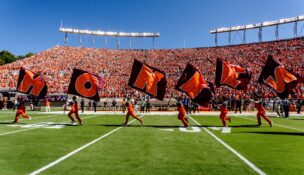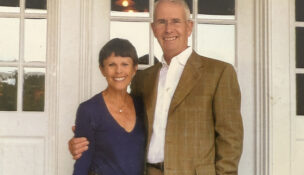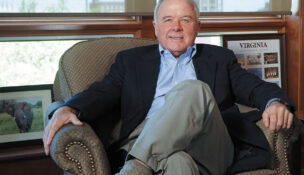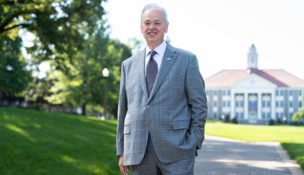The way forward
Valley Scholars program offers in-need locals a path to college
Don Harrison //March 1, 2020//
The way forward
Valley Scholars program offers in-need locals a path to college
Don Harrison //March 1, 2020//
The daughter of Mexican immigrants, Amy Cortes always figured that she’d go to work as a day laborer like her parents after she graduated from Fort Defiance High School. But somewhere along the way, the Augusta County teen decided, “I wanted to push myself and go to college.”
Last year, Cortes, 18, was one of 31 students in the first cohort of high school seniors to successfully complete James Madison University‘s Valley Scholars program. Begun in 2014, the program recruits potential first-generation college students from low-income backgrounds across the Shenandoah Valley.
Starting in middle school, students are mentored by JMU students and faculty and introduced to higher education and its various academic disciplines. The pupils can receive a full scholarship to JMU if they stay in the program through their senior year of high school and meet the university’s standards for admission. JMU partners with seven area school divisions — encompassing 22 middle and high schools — for the Valley Scholars initiative.
Now a JMU freshman, Cortes hopes to become an occupational therapist and is working toward a degree in kinesiology. “This may not have happened if I didn’t go through the program,” she says.

A new world
Valley Scholars was inspired by an initiative that JMU President Jonathan Alger helped to establish in 2007 when he was vice president and general counsel of Rutgers University. “One word that I would use to describe the intent of the Valley Scholars program is ‘hope,’” he says. “The idea is to be life-transforming by giving these students a chance at an age early enough when you can still affect the trajectory of their lives and educational careers, to tell them that finances are not going to be a barrier and that college is an option available and open to them … and that they’re not in this alone.”
There are residual benefits too, he adds. “We have JMU students that serve as the Valley Scholar mentors, and they are in the middle and high schools on a weekly basis. This is having an effect on the scholars, but also on JMU students, many of whom are interested in the field of education or want to be future teachers themselves.”
Cortes, a first-generation American citizen, says the Valley Scholars program opened up her world.
“In the beginning, in eighth and ninth grade,” she recalls, “I feel like they were more focused on developing our soft skills and introducing us to JMU’s campus. I like to call that the fun stuff. Once we got into high school, and AP classes were available, they started focusing more on academics. … They’d bring us to campus and I would learn about the majors here, and learn about [different] academic interests. There was a good support system, too. If there were times [when] high school got hard academically or emotionally, the staff was always available to us.”
Among the highlights of her study was the chance to travel with other scholars to Richmond and have lunch with the city’s mayor, Levar Stoney, a JMU graduate.
‘Bright and capable’
“This program fills a need in the community because we’re reaching students who otherwise may not attend college,” says Shaun Mooney, who has served as director for the Valley Scholars program since its inception. “In some cases, we’re improving outcomes. There are a lot of bright and capable kids living in rural areas, and if we provide that access and training and support from eighth grade all the way up to 12th grade, their outcomes are going to be better.”
Students apply for the program at the end of seventh grade. “They have to be low-income, and that would mean they are on free or reduced lunch in the public schools,” explains Mooney. “Their teachers and their principals and guidance counselors also have to identify them as having the academic ability and potential to pursue college education. And they have to be first generation … the first person in their immediate family to have attended a four-year college.”
Currently, 196 students from across the Shenandoah Valley in grades eight-12 are participating as Valley Scholars. Thirty-one of the first 35 participants completed the program and all 31 have entered college — 26 are attending JMU and five went to other institutions, leveraging scholarships and Pell Grant funding.
“And 10 of those [26] now participate in the JMU Honors program. That’s a huge deal,” adds Mooney. “In another four years, we’ll see how many of those students persisted and graduated with their college degrees.”
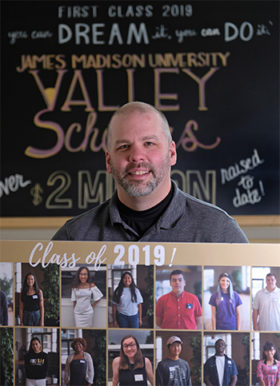
A helping hand
JMU is not the first Virginia college to start an outreach program for disadvantaged high schoolers or to recruit first-generation college students, for that matter. Other programs include George Mason University’s Early Identification Program, a college prep system for first-generation students that began in 1987. And, since 2007, the University of Virginia has offered a “College Guides” initiative in which U.Va. students advise in-need high school students statewide.
However, the Valley Scholars program is different, Alger argues, because it concentrates on the rural areas surrounding the university. “The emphasis on geography is important. We want to be a good neighbor and good partner with our local schools and the communities around us. And we saw that there was a significant need when we did the research. There were a lot of students in Harrisonburg and Rockingham and Page and Shenandoah and Augusta who clearly were not going to college because they came from disadvantaged backgrounds.”
The cost to fund JMU scholarships for the first five cohorts of Valley Scholars is divided between private donors and university funding, and is estimated to be around $7.5 million, officials say.
“I’m very impressed with the program,” says Bill Holtzman, the owner of Mount Jackson-based Holtzman Oil Corp., and a JMU philanthropist who has donated $650,000 to the Valley Scholars. “For the money spent, I get the biggest return that I can imagine.”
Holtzman’s alma mater is Virginia Tech, where he’s a generous donor. (Tech’s Holtzman Alumni Center is named for him.) But he also supports the school in his own backyard. “I live near [JMU] and my businesses are in Harrisonburg … and I like to pay back,” says Holtzman, who intends to keep supporting Valley Scholars. “It opens up the doors for children who, as they say, need a little help.”
A time for growth
Amy Cortes and her fellow cohort members feel lucky “knowing that there are people behind us, supporting us,” she says. “Once we get to college, they let go … but they still check up on us. It’s like a family that has been created.”
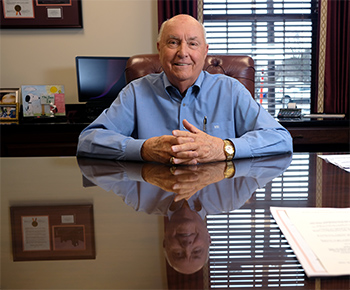
“Four of our students graduated from the program last year and all four are at JMU now,” reports Michelle Swab, a guidance counselor at Stonewall Jackson High School in Shenandoah County. Her job is to coordinate between the school’s 23 current Valley Scholars and the university. “Not only is this a huge help financially, it also gets the students ready to handle college. Without this, I don’t know if they’d be able to go straight from high school to a four-year college.”
Hundreds of people — public school teachers and JMU faculty, student mentors and program officials — work with the students year-round. But the program also involves another important group: parents.
“We do family workshops where all of the families come in and tackle different issues that could be obstacles or barriers to the students. Very few programs do that,” Mooney says.
The first class of Valley Scholars is entering the university at a time of notable growth and expansion for James Madison. The school’s nursing program, housed in the state-of-the-art Health and Behavioral Sciences building, has recently begun admitting 23 additional students per semester for a cohort of 113, a 25% increase. And sounds of construction ring out across the grounds. A new 8,500-seat Atlantic Union Bank Center — designed for Dukes basketball games as well as concerts — is being readied for 2021, as is a new $72.1 million College of Business building.
“There’s a lot of work that we’re doing on our campus, in conjunction with the community, to live out this vision we have of being a national model of the engaged university,” says Alger. “One of our goals is to make sure we’re providing access and opportunities to students of all backgrounds — whether socio-economic, racial [or] ethnic.”
S


